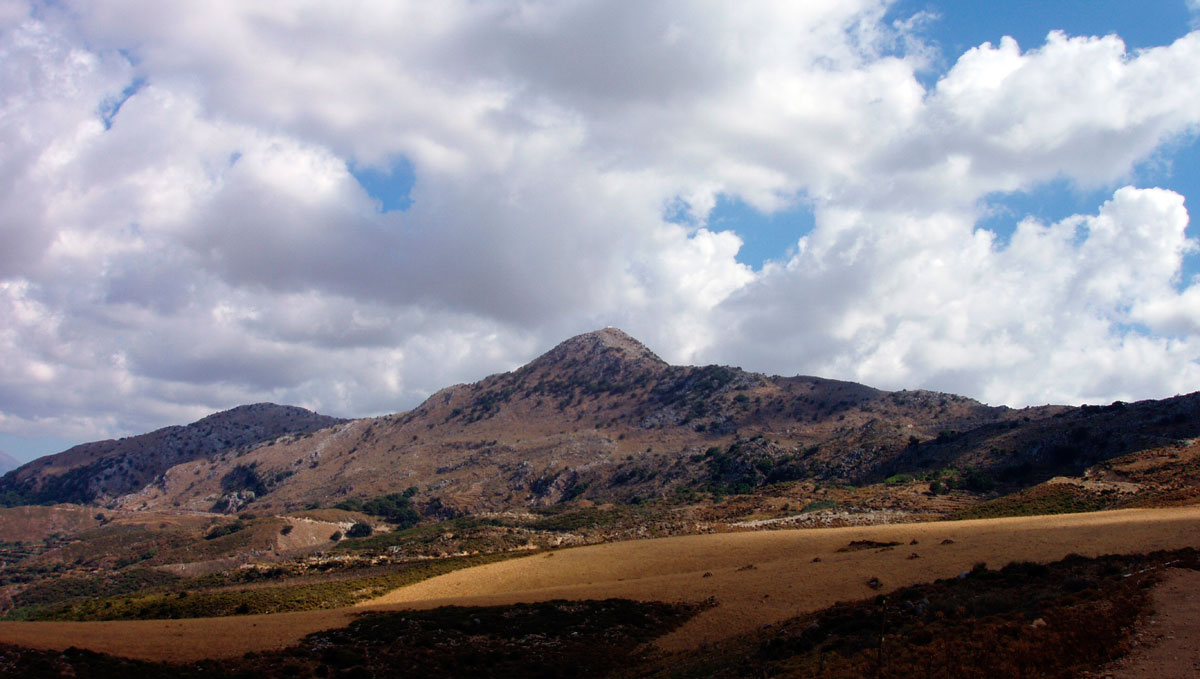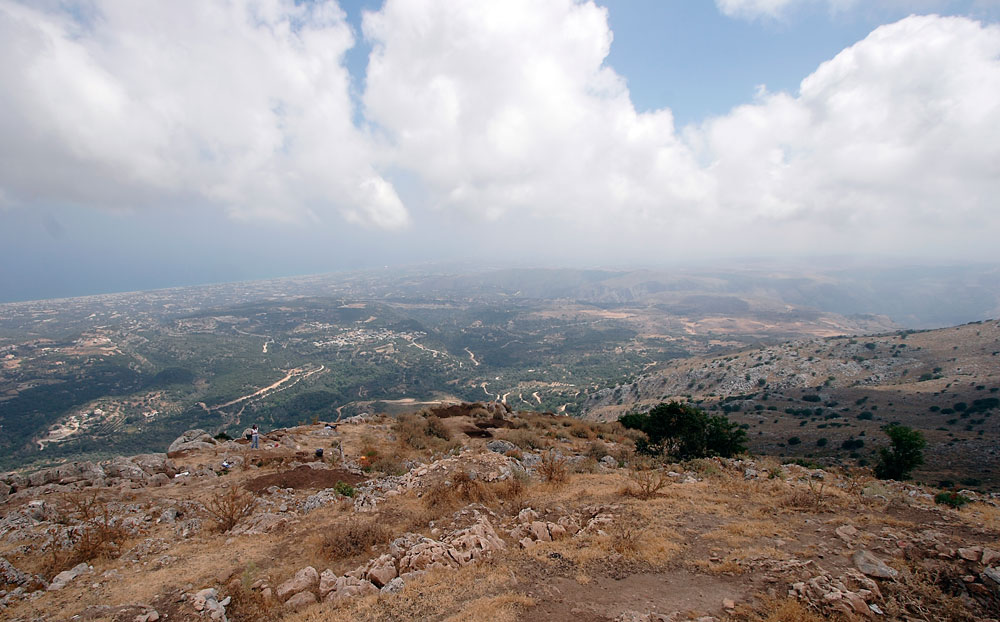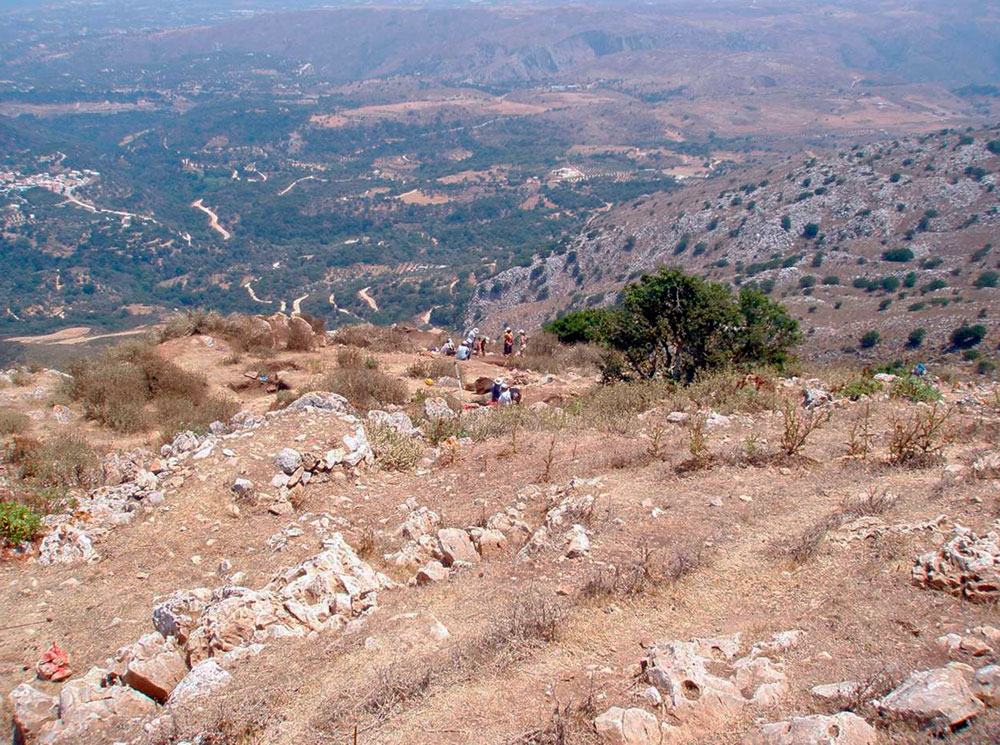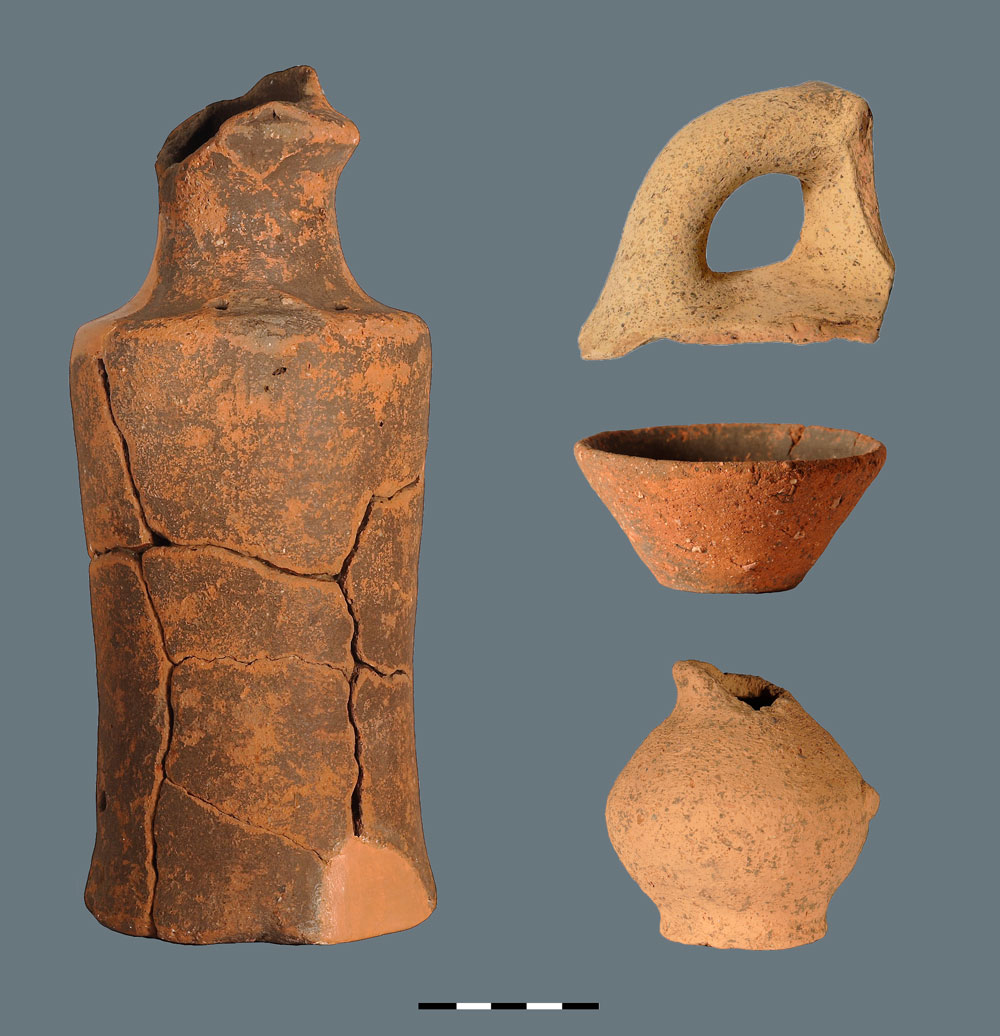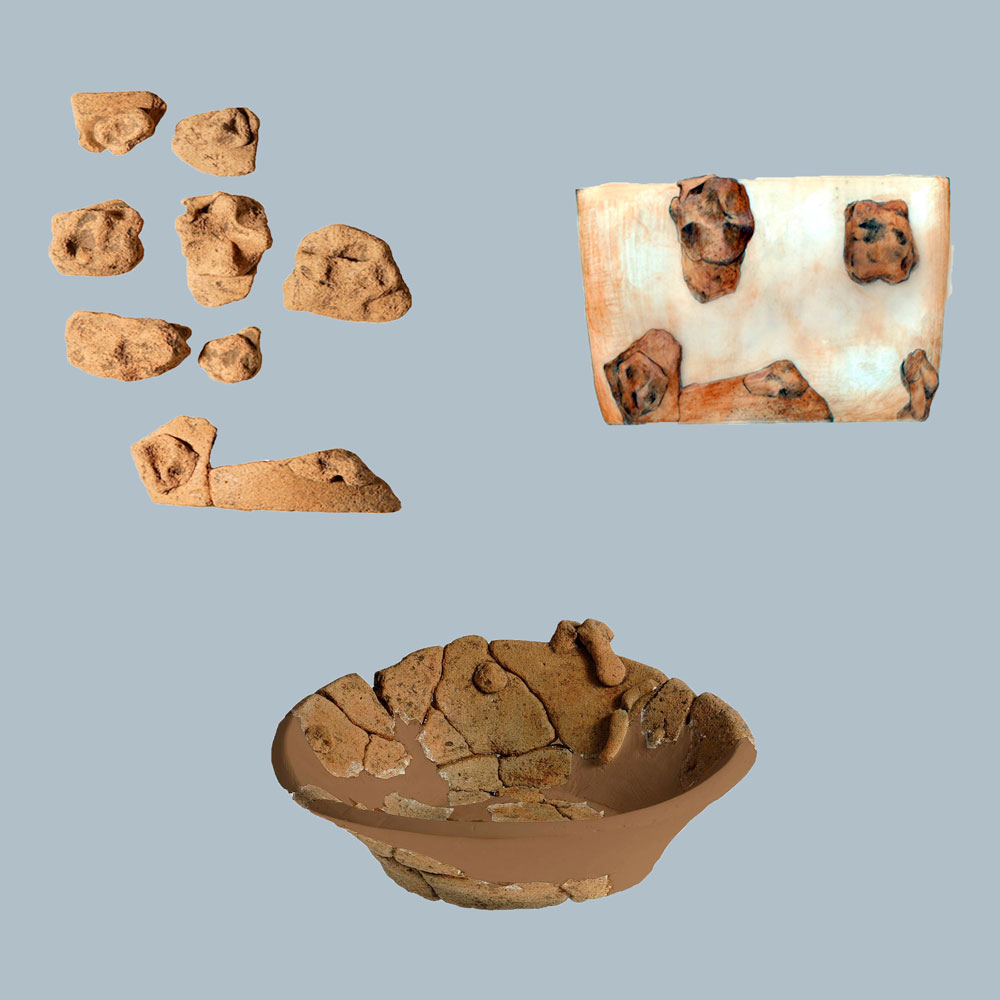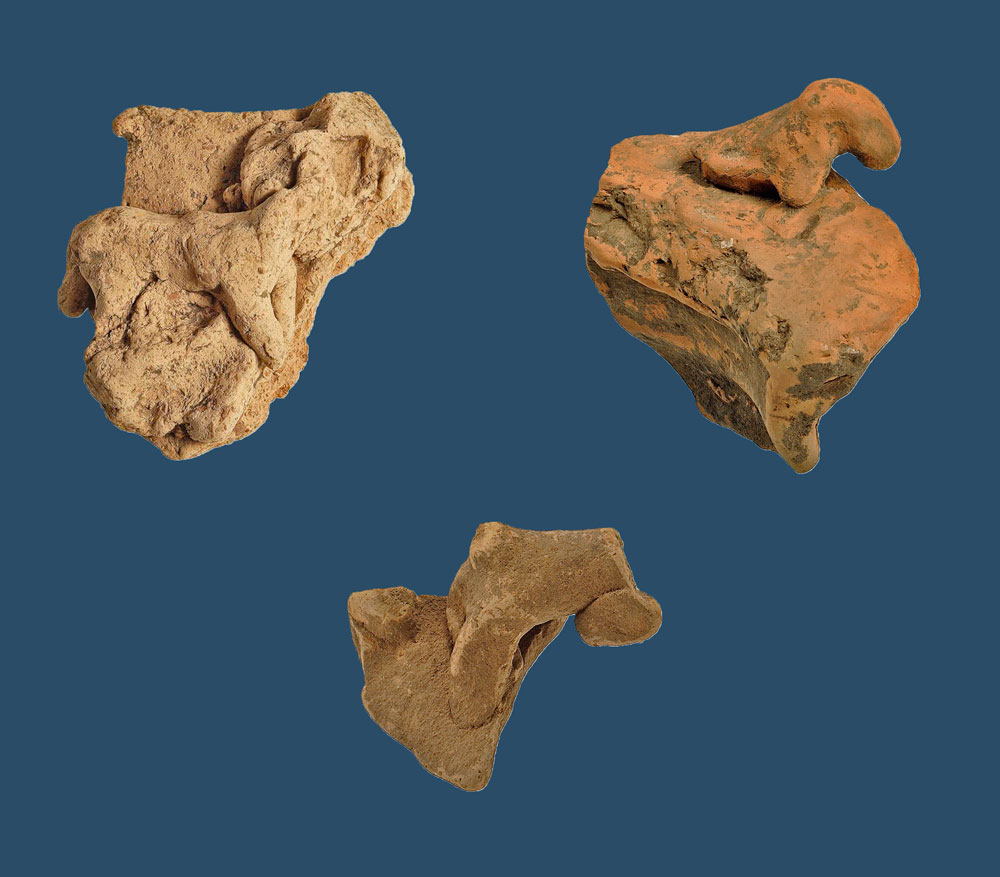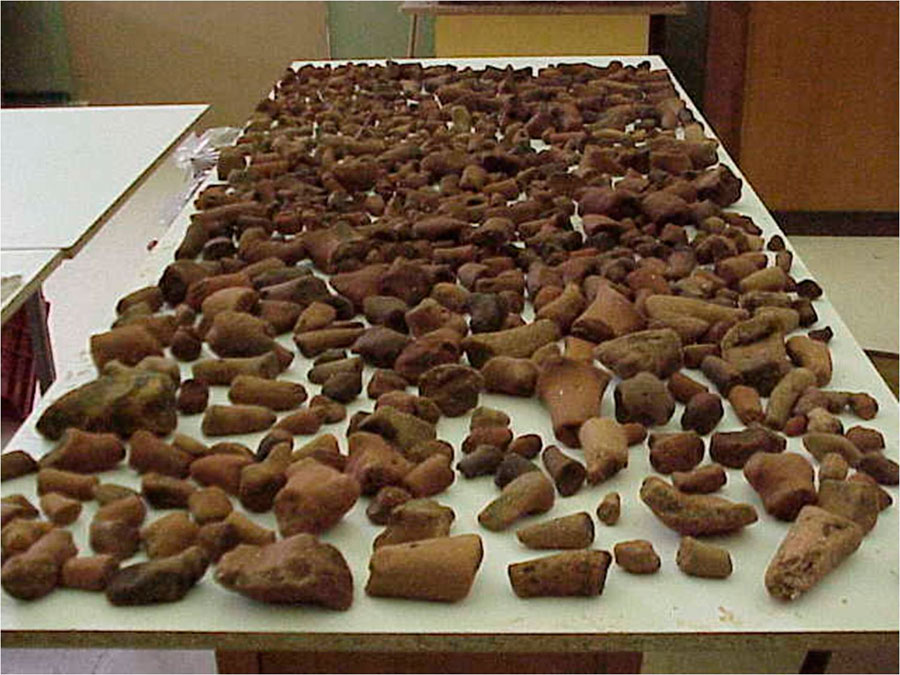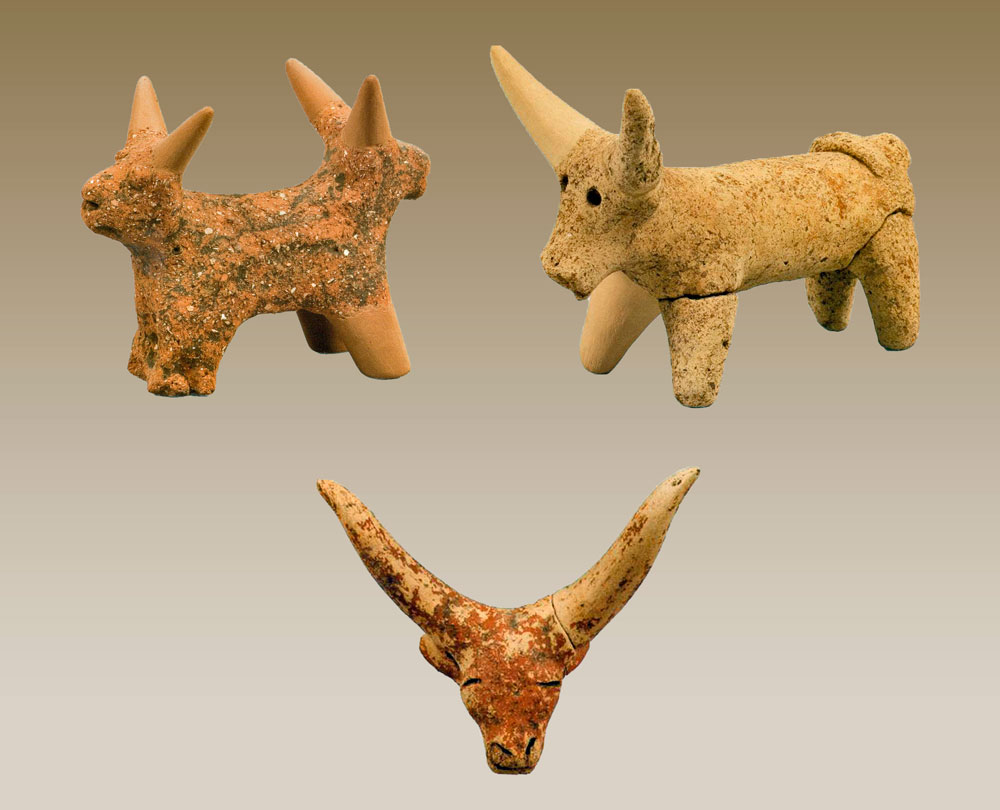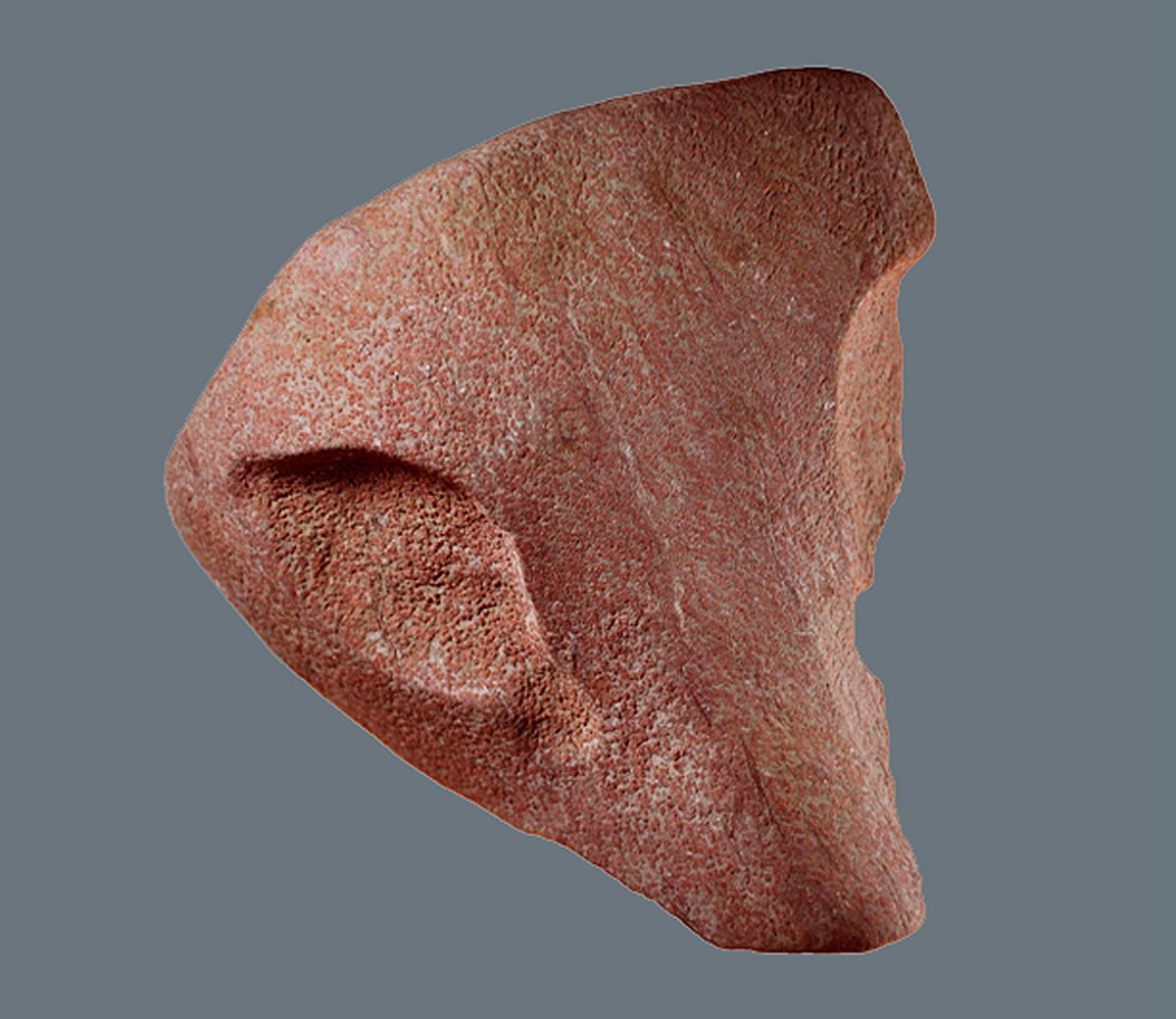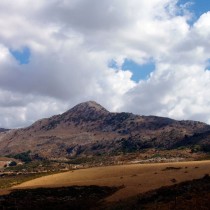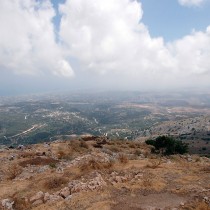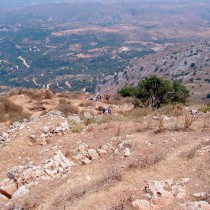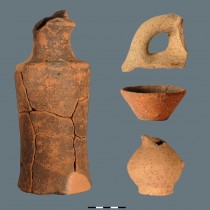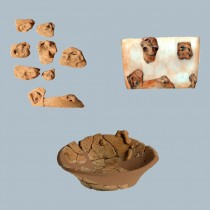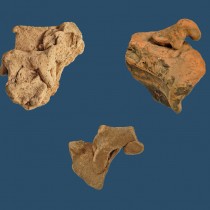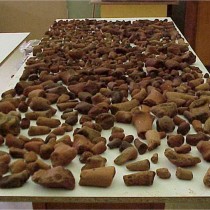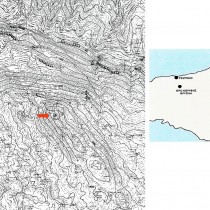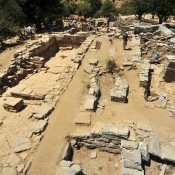When you raise your eyes from Rethymno to look south, turning your back on the sea, your gaze fixes on the mountainous mass of Vrysinas, and particularly its highest peak, Agio Pneuma (858 m. asl), which dominates the south end of the Vrysinas range. The hill is visible from all around: from the northern plateaux, from the sea, from the Latzimas valley to the east, and from Gallos and the area and cemetery of Armeni to the west. For centuries this high hill with its small structures on the peak, especially the small church of the Holy Spirit, has been a landmark that draws the eye, inescapably, a place of potentially multiple signification (fig. 1).
When, conversely, you climb up to the peak, either along the modern road or along one of the old footpaths that converge there, still used by flocks of sheep and goats today, it assumes another aspect. Things look different from the peak. The line of sight across the whole area unfolds in all its majesty, including the valley of Agios Vassilios (figs. 2, 3). From the peak there is an all-embracing view of the surroundings, a comprehensive “geographical” picture. You can better observe and evaluate the manmade historical landscapes and the various ways in which they have been formed, from the hills clothed in olive and cypress trees to the higher meadows, the terraces and the protected valleys with their springs. That is why, as far as we know, it has always been a lookout point from the late medieval period to the present day; it is currently used by the Fire Service as an observation point for possible wildfires.
From the peak, you also become aware of something else: that the picture of the apparently high, isolated and almost inaccessible peak seen from below is completely relative. The peak is easily accessible and rises in a “tamed” landscape. Around it, and particularly to the south, are scattered plateaux, miniature depressions everywhere, alluvial dolines formed by the waters of the limestone masses and centuries of human activity. Ploughed, verdant, with rocks and stones to retain moisture, combined with the planted terraces they make the landscape friendly, human, not in the least steep or inaccessible. This is all pastureland now, but up until a few decades ago people used to cultivate vegetables that needed no watering, growing with the night dew and the moisture of the soil. This was the aori (mountain) of the various villages, laid out like a garden in a patchwork of small fields. The inhabitants call the plateau surrounding the peak of Agio Pneuma a kambos, or plain. So the hilltop, where the Peak Sanctuary stands, is by no means isolated. It is within easy walking distance of the farming and inhabited areas. In any case, the surface survey around the hill has identified, mainly to the northeast but also to the south and west, LM IIIC settlements, so-called “refuge settlements”, although in our case their position and the surrounding terrain are probably evidence of a choice dictated by economic exploitation of the uplands.
The Minoan phenomenon of the Peak Sanctuaries
The so-called Peak Sanctuaries, which despite their name are not always on peaks but in a high location, are a phenomenon almost exclusively characteristic of Minoan archaeology. On a reasonably elevated site, usually a windy hill with good lines of sight, as at Vrysinas and Petsofas, but sometimes also on a slope as at Atsipadhes or Kofinas, an astonishing multitude of specific and special finds with a relatively limited spatial dispersal appeared during a specific period (c. 1800 BC). These are often but not always accompanied by buildings (Juktas, Petsofas, Traostalos). The terrain is often terraced: people used the natural features of the hill and reinforced them with structures and by cutting into the rock, giving the bedrock a manmade form. They added buildings, although probably few of these, since the sanctuaries were largely open-air, and ensured that there were some levelled areas where people could congregate. It is mainly the huge number of finds (figurines and masses of shattered pottery) that indicates that this was a place for ceremonies, cult offerings and, in any case, a gathering-place for many people, perhaps for various reasons other than worship (collective decision-making, dispute-solving, ritual meetings of clan groups at regular intervals). The frequent discovery of burnt bones and traces of ash has led to the hypothesis that the ritual may have included nocturnal sacrifices and libations (note 1).
The finds from the Peak Sanctuaries present quite a few similarities in general categories (pottery, figurines, stone vessels, etc.), and also quite a few differences (different proportions and densities, and different types of find). Nonetheless, they do have one characteristic in common: their exceptionally fragmentary state. They consist of pottery shattered into tiny pieces and huge numbers of figurines, very badly damaged. This renders their thorough study difficult and is one of the reasons their interpretation is problematic. Peak Sanctuaries lend themselves to all sorts of theories, and, in spite of all the analyses, remain as much of an enigma as they were when they first appeared in Minoan Archaeology, in the first decade from its inception, with Myres’s excavation on Petsofas (note 2). The fact that they appear at many Cretan sites, particularly in the east of the island, tends to make them seem a regular feature, but this does not eliminate the difficulties of analysis. No Peak Sanctuary has been published in full. Neither their nature nor their historicity is well understood, nor how and why this phenomenon appeared at a specific moment in time and disappeared a few centuries later. Many studies on the issue have, however, been carried out, focussing on the cult ceremonies and forms of ritual on the one hand, and on the systematisation of the find categories on the other (note 3). The relationship of the Peak Sanctuaries to the palaces and the centralised administrative system is also widely discussed (note 4).
Most Peak Sanctuaries are associated with towns, as is the case with Petsofas (linked to the town of Palaikastro) and Juktas (linked to the town and palace of Knossos). Most flourished during the Protopalatial period, like Atsipadhes (note 5). However, some of the larger ones, such as Juktas, Traostalos, Vrysinas or Kofinas, are connected to the main Neopalatial phase, the peak of Minoan civilisation. There has been much discussion on the issue of how far they led to the centralised administrative system of the palaces, were placed under its influence, shrank, or even disappeared from it altogether.
The Vrysinas Peak Sanctuary
The site on the peak of Agio Pneuma was located an identified as a Peak Sanctuary by Paul Faure in 1963. The extensive Davaras excavation took place in 1972 and 1973, producing a very large number of figurines and pottery. With the excavator’s permission, the present author with a team of postgraduate students undertook the study of the figurines, estimated to number at least 6,000 and consisting of approximately 30,000 fragments, and the pottery, weighing around 1.5 tons. A new excavation was carried out between 2004 and 2011 by the Department of History and Archaeology of the University of Crete and the 25th Ephorate of Prehistoric and Classical Antiquities (note 6).
History of human presence
The peak of Vrysinas is very close to inhabited areas but is not itself habitable. It is often hidden in the clouds, almost permanently buffeted by the winds, and the only water sources are very low down, rendering permanent habitation almost impossible. Therefore human presence is not diachronic; it occurs at a very early date but only sporadically, and is probably seasonal. It is connected to special occasions in human life, with rare attendance for the confirmation of community, for instance with regular rituals or extraordinary gatherings.
From the archaeological finds, the human presence on Vrysinas is datable long before the use of the site as a sanctuary. There are traces of habitation from the Final Neolithic period (4000-3200 BC), consisting of a few stone tools and a reasonable quantity of sherds from a few dozen vessels, mostly deep or shallow bowls. This phase of habitation does not appear to have lasted long and was limited in extent. It is connected to the phenomenon of the presence of small Neolithic installations on high sites across Crete during the Final Neolithic. This was a temporally isolated episode, as there are no indications of human presence in the following period, that of the Early Bronze Age (3200/3000-2100 BC).
Traces of human presence are seen again in ΜΜΙ (2100-1900 BC), attested by a few characteristic vessels (handleless cups, Barbotine Ware vessels). Another clear archaeological indication of this phenomenon, a large concentration of human and animal figurines and a large quantity of broken pots, belongs to the next period, ΜΜΙΙ. We can recognise the vessels of the time, the two-handled bridge-spouted jars, the cups, the small jugs, etc. (fig. 4). The pottery of this period is richly decorated, polychrome and hugely varied. The decoration is sometimes schematic but very commonly pictorial. The frequency of plastic decoration on vessels of all kinds, large and small, is impressive. Clay applications on the inner or outer surfaces, on the rims or handles, represent rocks, roosting birds, coiled snakes and animals running and straddling rocks (figs. 5, 6). Thus are formed landscapes of enormous interest as regards the methods of conceptual and artistic depiction of space and depth (note 7).
The main bulk of the material is dated to ΜΜΙΙΙ-LΜΙA (1700-1500 BC), the beginning of the Neopalatial period. Generally speaking, the look of the vessels changes. The polychromy and plastic decoration disappear. The pottery becomes more standardised and plainer. The shapes are jugs, amphorae, trays, tripod cooking pots, kadoi. The most striking feature of this phase is the huge number of conical cups, numbering approximately 8,000 – over 75% of the pottery of this period. There is a clear tendency towards standardisation, not only in the conical cups but in the rest of the pottery too. Most importantly, the numbers of vessels and figurines increase massively, meaning that the frequency of visits to the Peak Sanctuary also rose dramatically (fig. 4). The types of vessel also indicate the type of ritual activity engaged in. We do not know precisely what went on, nor when, nor at what time of year, nor whether it was day or night. From the vessel types, however, we can guess that people ate and drank in large numbers, communally, because the remains of the banquets and wine-drinking have been preserved. The kadoi and tripod cooking pots also indicate that some kind of food preparation would have taken place on the spot.
There is also some limited pottery from LM IIIB and C (1350-1000 BC), the end of the Minoan period, which is usually linked to the Mycenaean presence on Crete. However, it is unclear whether, at the end of the Late Bronze Age, the human presence on Vrysinas is associated with some form of continuity of cult phenomena or whether it is simply connected to contemporary habitation around the hill, attested by the surface survey. Human presence continues into the Early Geometric and Archaic period before disappearing. A few rare Hellenistic sherds are not serious indications of use of the site. Essentially, groups of people reappear at the site in late medieval times, when cult phenomena are seen again with the presence of ecclesiastical buildings. From then on, throughout the periods of Venetian and Turkish rule, the peak, apart from its religious function, was also used as a lookout post. This is also the case today; as we have said, in the summer the site is a Fire Service observation point.
The finds
The main type of find is the figurines, human and animal, which are exceptionally numerous and exceptionally fragmentary. Very few are preserved enough to allow their restoration. Essentially, we have a huge number of fragments of various parts: very often legs and horns, heads, bodies or arms. Almost all are handmade. These are generally considered to be votive offerings and placed in ritual contexts, although neither their role nor their numerical explosion (by thousands in a few decades), nor their image-making significance is fully understood (note 8).
The animal figurines are almost all bovids. Many are solid, but most have a hollow body. The head is always solid, while in a very few cases of larger figurines, the head was cast in a mould before being attached to a hollow body (fig. 7).
The dimensions of the animal figurines vary widely, much more than those of the human ones: from just 5 cm long to large figurines 80 cm long and 60 cm high. These sizeable figurines, almost statuettes, date from the final era, the Neopalatial period. Large numbers of figurines are painted black, while others are a vivid reddish-brown. Some are portrayed with two heads, presumably due to the particular symbolic significance of the head and horns (fig. 8). The chronological context corresponds to that of the pottery: there are a number of black, monochrome, medium-sized and fairly schematic figurines, dating to the Protopalatial period, while the majority are larger and slimmer, with reddish-brown slip, and date to the Neopalatial period. Given that very few animal figurines from Crete, and even fewer from the Peak Sanctuaries, have been published, it is extremely difficult to find parallels. Consequently this extremely numerous assemblage (over 4,000 figurines), preserves its own unique character, as does the multitude of human figurines.
There are also bronze finds, relatively limited compared to those discovered at other Peak Sanctuaries: bronze figurines of worshippers and miniature ceremonial axes. There were not many stone finds either; they are limited to nine offering tables and a few fragments of stone vessels and model foot soles. But they do include a splendid object: the head of a feline, exceptional in its artistry and monumentality (fig. 9).
Written evidence and potter’s marks
At Vrysinas appear most of the means of written symbolic communication known in Crete during the periods of the Old and New Palaces: Minoan Hieroglyphics, Linear A signs and potter’s marks. Let us begin with the last. Various incisions are often found on various parts of vessels, often resembling but not identified with written signs. These are called potter’s marks. Their function remains enigmatic. No overall explanation for their presence has been provided, and so far the reason for the marking of a very few pots is still unknown in spite of the theories advanced. At Vrysinas there are approximately 70 marks on a total of over 100,000 sherds. Apart from these, there are also various inscriptions on vessels that have been identified as Linear A. In 2011 a four-sided prism seal was discovered, bearing hieroglyphic signs – the only evidence of the use of Hieroglyphic script in West Crete to date.
The presence of these testimonies, although we will not go into this subject in detail, means that the surrounding area, where the visitors came from, was a region with a social organisation corresponding to that of the better-known areas of Central and East Crete, with written communication, political and trading relations and exchanges of forms of worship. We must suppose that the surrounding area participated in the urbanisation observed in other parts of Crete and led to the establishment of systems of administrative and exchange systems that left written evidence.
Proposed interpretation
It was obvious right from the start that Vrysinas could not be treated as just another case of the Minoan phenomenon of Peak Sanctuaries, which we restrictively call one of cult. In order to approach Vrysinas as a historically interpretable phenomenon, proper attention must be paid to the specific historical moment at which it flourished and to that at which it was abandoned, as well as to the specific geographical context.
This is why, apart from the in-depth study of the finds, we must also examine the network of settlements surrounding the mountain, for which it forms a reference point. It must not be treated as an isolated phenomenon of symbolic deposition, only indicative of ceremonies and human gatherings. The mountainous mass of Vrysinas and the peak of Agio Pneuma stand at the centre of a productive, inhabited area. Any activities that took place there are better understood in the context of the country and the villages which engaged in them. This requires an understanding of the resources, the changes in the landscape, and the settlement pattern in the wider environs. The mountain must be studied as a whole, its natural terrain and human behaviour examined in tandem: we must comprehend the routes, the footpaths, the springs, the place-names, the human visibility.
To this end, two studies were carried out in parallel. One was a systematic surface survey around the hill, shedding light on the extent and nature of the human occupation of the area, while the second was a technical and petrographic analysis of the ceramic fabric of the vessels, in the hope of achieving a land-use evaluation of the extent and limits of the country, the area from which the visitors came. The surface survey, carried out by K. Sbonias, provides answers as regards the access routes to the hill, the surrounding installations and the exploitation of resources.
The analysis of the pottery fabrics has demonstrated the multiplicity of technical traditions, which means that the vessels used on the hill came, like the visitors who brought them, from many different places. These places are not far distant, probably no more than 20 kilometres away as the crow flies. This reinforces the view that the Peak Sanctuary was a reference-point of local significance but high symbolic importance, as its abundance of visitors shows.
Thus the exceptional phenomenon of one of the high peaks of the Vrysinas range becoming a public gathering-place may take on other interpretations, beyond those of worship but complementary to them. Seasonal meetings, communal feasts following sacrifices, gatherings of kin-groups and generations, may have taken place in ritual ways and in a cult context, but the content was similar to what we would nowadays call a political function. Alliances of kin-groups and solving of disputes, agreements on pastureland and use of springs, exchanges of gifts and speeches, amid oaths of friendship, pledges of faith, songs, hymns, dances and perhaps coming-of-age ceremonies and marriages. A hubbub of humans and animals, different scents, the rustle of clothing, shouts, the sounds of footsteps and panting up and down the hill by many, many people, children and animals would have made up the lost picture that we are trying to restore. Their movements, their rhythms, their timescales, their feelings and, above all, their words, escape us. But we must not forget that these things existed, and that they determined the material testimonies that we hold in our hands.
Iris Tzachili
Professor Emerita of Prehistoric Archaeology, University of Crete
